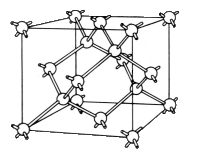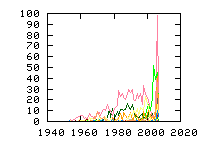« Previous
1
Next »
(13 hits, 1/1)
Showing
10, 25, 50, 100, 500, 1000, all papers per page.
Sort by:
last publication date,
older publication date,
last update date.
- 1. phys. stat. sol. (a) 55, 251 (1979) , “Photo-EPR of Dislocations in Silicon”, R. Erdmann, H. Alexander.The dependence of the EPR spectrum of dislocations in deformed silicon on illumination with monochromatic light reveals the two EPR centers Si - K1 (S < 1/2) to be different ionization states of one and the same dislocation center. The energy level separating these ionization states lies near the... (Read more)
- 2. Phys. Rev. Lett. 48, 37 (1982) , “Optical Detection of Magnetic Resonance for a Deep-Level Defect in Silicon”, K. M. Lee, K. P. O'Donnell, J. Weber, B. C. Cavenett, and G. D. WatkinsOptical detection of magnetic resonance is reported for the 0.97-eV luminescence in neutron-irradiated silicon. The resonance is of an excited triplet (S=1) state of the defect, which is not the radiative state, known to be a singlet (S=0). The spectrum is unusual in that it is characteristic of a... (Read more)
- 3. Sov. Phys. Solid State 28, 1862 (1986) , “Electron states having spin S ≥ 1 at dislocations in silicon”, M. N. Zolotukhin
- 4. Phys. Rev. B 34, 7524-7533 (1986) , “Fundamental radiation-induced defect centers in synthetic fused silicas: Atomic chlorine, delocalized E' centers, and a triplet state”, D. L. Griscom and E. J. FriebeleA series of synthetic fused silicas of diverse OH contents was subjected to 100-keV x irradiations at 77 K and investigated by electron-spin-resonance techniques at ?110 K or higher temperatures. Spectra were recorded at X-band frequencies (?9.2?9.3 GHz) both as the first derivative of absorption... (Read more)
- 5. J. Non-Cryst. Solids 179, 1-9 (1994) , “The many varieties of E′ centers: a review”, Robert A. WeeksThree varieties of E′ centers with a spin state, S = 1/2, and with a G-tensor, Gx Gy 2.0003, Gz 2.0018, were identified in the early reports on paramagnetic states in irradiated α-quartz. The atomic structure of two of these had an hydrogen ion (proton) in nearby sites and hence... (Read more)
- 6. J. Non-Cryst. Solids 239, 16-48 (1998) , “Optically active oxygen-deficiency-related centers in amorphous silicon dioxide”, Linards SkujaThe spectroscopic properties, structure and interconversions of optically active oxygen-deficiency-related point defects in vitreous silica are reviewed. These defects, the E′-centers (oxygen vacancies with a trapped hole or 3-fold-coordinated silicons), different variants of diamagnetic... (Read more)GeO2 SiO2| EPR PL gamma-irradiation optical-spectroscopy| 0.5-1.0eV 1.0eV~ 1H 2.0eV~ 3.0eV~ 4.0eV~ 5.0eV~(larger) Chlorine E' E'-alpha E'-betha E'-delta E'-gamma Germanium H(I) H(II) Hydrogen ODC ODC(I) ODC(II) OHC Oxygen POR Silicon amorphous dangling-bond dielectric interstitial pair(=2) surface triplet vacancy | last update: Takahide Umeda
- 7. Phys. Rev. B 59, 12900 (1999) , “Electron-paramagnetic-resonance measurements on the divacancy defect center R4/W6 in diamond”, D. J. Twitchen, M. E. Newton, J. M. Baker, T. R. Anthony, W. F. BanholzerElectron-paramagnetic-resonance (EPR) studies in radiation damaged diamond enriched to 5% 13C have resulted in the identification of the nearest-neighbor divacancy center. It is the isotopic enrichment, and consequent observation of 13C hyperfine lines, that has permitted the... (Read more)
- 8. Phys. Rev. Lett. 92, 135502 (2004) , “Hydrogen Incorporation in Diamond: The Vacancy-Hydrogen Complex”, C. Glover, M. E. Newton, P. M. Martineau, S. Quinn, D. J. TwitchenWe report the identification of the vacancy-hydrogen complex in single crystal diamond synthesized by chemical vapor deposition. The S = 1 defect is observed by electron paramagnetic resonance in the negative charge state. The hydrogen atom is bonded to one of the carbon atoms neighboring the... (Read more)
- 9. Phys. Rev. Lett. 93, 086102 (2004) , “Reaction of the Oxygen Molecule at the Si(100)–SiO2 Interface During Silicon Oxidation”, Angelo Bongiorno and Alfredo PasquarelloUsing constrained ab initio molecular dynamics, we investigate the reaction of the O2 molecule at the Si(100)–SiO2 interface during Si oxidation. The reaction proceeds sequentially through the incorporation of the O2 molecule in a Si-Si bond and the... (Read more)
- 10. Phys. Rev. B 70, 235211 (2004) , “Structure and vibrational spectra of carbon clusters in SiC”, Alexander Mattausch, Michel Bockstedte, and Oleg PankratovThe electronic, structural, and vibrational properties of small carbon interstitial and antisite clusters are investigated by ab initio methods in 3C- and 4H-SiC. The defects possess sizable dissociation energies and may be formed via condensation of carbon interstitials, e.g.,... (Read more)
- 11. Phys. Rev. Lett. 96, 55501 (2006) , “Divacancy in 4H-SiC”, N. T. Son, P. Carlsson, J. ul Hassan, E. Janz?n, T. Umeda, J. Isoya, A. Gali, M. Bockstedte, N. Morishita, T. Ohshima, H. ItohElectron paramagnetic resonance and ab initio supercell calculations suggest that the P6/P7 centers, which were previously assigned to the photoexcited triplet states of the carbon vacancy-antisite pairs in the double positive charge state, are related to the triplet ground... (Read more)
- 12. phys. stat. sol. (b) 245, 1298-1314 (2008) , “EPR identification of intrinsic defects in SiC”, J. Isoya, T. Umeda, N. Mizuochi, N. T. Son, E. Janzen, T. OhshimaThe structure determination of intrinsic defects in 4H-SiC, 6H-SiC, and 3C-SiC by means of EPR is based on measuring the angular dependence of the 29Si/13C hyperfine (HF) satellite lines, from which spin densities, sp-hybrid ratio, and p-orbital direction can be determined over... (Read more)Si SiC diamond| EPR Theory electron-irradiation thermal-meas./anneal-exp.| +1 -1 0(neutral) 1.0eV~ 13C 29Si C1h C3v Carbon Csi D2d EI5/6 HEI1 HEI9/10 P6/7 Silicon T1 Td Tv2a V1/2/3 Vc Vsi antisite dangling-bond mono(=1) motional-effect n-type p-type pair(=2) quartet semi-insulating spin-relaxation triplet vacancy .inp files: SiC/Baranov/Baranov_g.inp SiC/EI5_C1h/5.inp SiC/EI5_C3v/5.inp SiC/EI6_RT/6.inp SiC/HEI10/HEI10a.inp SiC/HEI10/HEI10b.inp SiC/HEI1_C1h/1.inp SiC/HEI9/HEI9a.inp SiC/HEI9/HEI9b.inp SiC/SI5_C1h/4.inp SiC/Ky2/Ky2.inp SiC/Tv2a/Main.INP SiC/Vsi-_II_4H/Main.INP SiC/Vsi-_II_6H/Main.INP SiC/Vsi-_I_4H/Main.INP SiC/Vsi-_I_6H/Main.INP | last update: Takahide Umeda
- 13. Phys. Rev. B 77, 195203 (2008) , “Creation and identification of the two spin states of dicarbon antisite defects in 4H-SiC”, J. W. Steeds, W. Sullivan, S. A. Furkert, G. A. Evans, P. J. WellmannThis paper deals with the positive identification by low-temperature photoluminescence microspectroscopy of the two spin states of the dicarbon antisites in 4H-SiC. The defects are created by high-dose electron irradiation at room temperature or by subsequent exposure to intense 325 nm radiation at... (Read more)
« Previous
1
Next »
(13 hits, 1/1)
Showing
10, 25, 50, 100, 500, 1000, all papers per page.
Sort by:
last publication date,
older publication date,
last update date.
All papers (3399)
Updated at 2010-07-20 16:50:39
Updated at 2010-07-20 16:50:39
(view as: tree
,
cloud
)
| 1329 | untagged |
Materials
(111 tags)
Others(101 tags)
Technique
(46 tags)
Details
(591 tags)
Bond(35 tags)
Defect(interstitial)(18 tags)
Defect(vacancy)(15 tags)
Defect-type(19 tags)
Element(65 tags)
Energy(8 tags)
Isotope(56 tags)
Label(303 tags)
Sample(17 tags)
Spin(8 tags)
Symmetry(15 tags)

